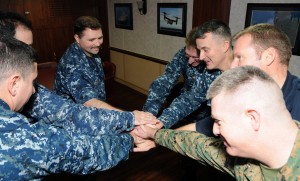Prior to the Bold Alligator 2012, Second Line of Defense visited with the planners and leadership of Expeditionary Strike Group 2. The ESG-2 team provided a core baseline to understand the approach and the objectives of the exercise.
https://sldinfo.com/esg-2-prepares-for-bold-alligator-2012/
https://sldinfo.com/planning-for-bold-alligator-2012/
We had a chance to come back after the exercise to discuss highlights and lessons learned with ESG-2. We will continue this discussion in the near future with 2nd MEF and 2nd MAW to gain a more complete understanding of the way ahead with regard to the approach to maneuver warfare highlighted in the exercise.

As we wrote earlier:
The Libyan operations and Bold Alligator 2012 provide important inputs to re-thinking maneuver warfare from the Sea. Both operations involve amphibious capabilities and the leverage of sea bases to re-shape how the US and its allies can operate in a new approach leveraging the available operational bases to achieve tactical and strategic dominance.
In our discussions of Libya, we focused on how the sea base can be integrated into an overall strike and sustainment operation. At the heart of the new approach is the ability to engage and to dominate through SUSTAINED operations. Such operations will require forces able to strike, to control the battlespace and then to prevail through the necessary period of the operation to achieve strategic and tactical objectives.
To sustain will mean that the sea bases will not just show up for a show of force, but be part of a sweep and sustainment operation. This will mean that the ability to operate from land, whether in close proximity or distance will be integrated into the thinking about the USN-USM strike force.
https://sldinfo.com/re-thinking-maneuver-warfare-from-the-sea/
During our visit on February 21, 2012, we had an opportunity to interview the Commander and Deputy Commander of ESG-2 as well as the chief coalition officer. There detailed interviews will published later next month. For now, we would like to provide highlights from the video portions of those interviews.
Admiral Scott
Admiral Kevin D. Scott, Commander, Expeditionary Strike Group 2, discussed the core objective of BA-12 from his point of view. On his wall, he has the famous quote from President Theodore Roosevelt delivered in a speech at the Sorbonne, Paris France, where the striving for excellence and achieving the difficult is the goal the leadership team focuses upon, not naysing and negativism.
Admiral Scott underscored that the core effort was to bring the USN-USMC and the coalition team together into an enhanced capability to operate from the sea. Re-crafting maneuver warfare from the sea is not just about technology and new capabilities; it is based on a con-ops where collaborative team efforts become seamless.
For an earlier interview with Admiral Scott aboard the USS Wasp during the F-35B sea trials see
https://sldinfo.com/admiral-scott-and-the-arg/
Colonel Weisz
Col. Bradley Weisz, Deputy Commander, Expeditionary Strike Group TWO, In this video portion of the interview, underscores some of the key items of interest from the perspective of ESG-2 and the way ahead.
Among the core points are the following:
The “logistics iron mountain” did not need to come ashore because of how the seabasing approach is being shaped and the integration of the Military Sealift Command ships into the strike force;
C2 remained aboard the ships, for only one of the four elements of the insertion of force carried their C2 forward off of the ships.
Weisz underscored the need and the opportunity to formalize BA-12 and to build a regular training capability for the ESG force similar to what has happened with the CBG or CVN forces.
Lt. Commander George Pastoor
The Lt. Commander provided insight on the exercise and the coalition role from the standpoint of lessons learned from the exercise.
As Pastoor noted in the earlier interview:
I’m basically on the inside, as I am a Naval Officer embedded in the Expeditionary Strike Group 2 staff, as well as coalition member, and so I’m seeing the process from both sides. I’m on the receiving end on one side, and I’m on the giving end on the other side as being the developer of the operations and the plans.
Coalition is a key part of Bold Alligator. It’s been there from beginning. From the very first concept development conferences in the beginning a year ago, coalition engagement was central.
Nowadays operations aren’t done without coalitions. The Bold Alligator process is U.S. and coalition as one team from beginning onwards. It’s really working well, getting to the same goals, doing the planning process together, working in close coordination with the French Task Group, having their plan’s over, having 6 to 10 officers from New Zealand flying in for planning conference.
We have a lot of coalition participants in our staff for the operation itself really emphasizes the importance of coalition.
It’s also been laid down on us from higher command levels that we need coalition at the center of the operational concept, and we want to have them as equal partners and as integral team members.
https://sldinfo.com/coalition-engagement-in-bold-alligator-2012/
In the video portion of the interview, the Dutch naval officer highlighted three key items.
First, the reliance on SIPERNET was problematical for coalition engagement. During the exercise CENTRIX was used as the coin of the realm. Pastoor underscored that planning needs to be done in CENTRIX so that there is a seemless flow to exercise and operational collaboration.
http://www.afsbirsttr.com/Publications/Documents/Transition-081409-Trident-AF03-079.pdf
Second, the Dutch had observers during the deep raid to Fort Picket. This 165 mile insertion was a far cry from the normal insertion capabilities and was enbabled by the Osprey. The Dutch were impressed with this transformational capability.
Third, Pastoor discussed the new maneuver concept from the sea which is about power projection that can go where the enemy is not and move more rapidly than the enemy.

